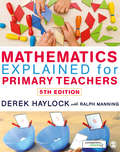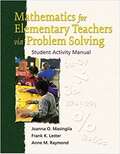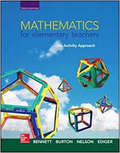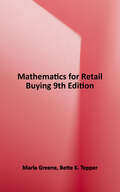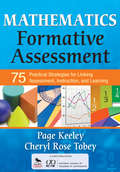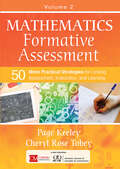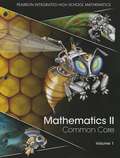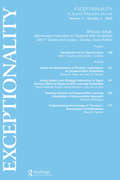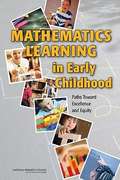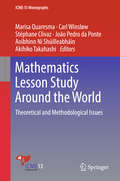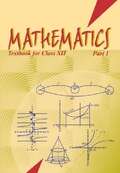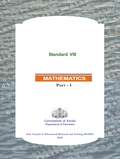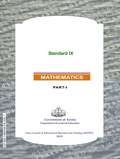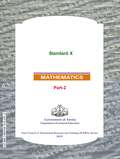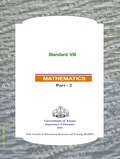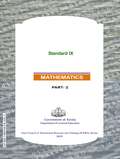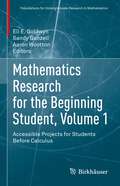- Table View
- List View
Mathematics Explained for Primary Teachers (Mathematics Ser.)
by Derek Haylock Ralph ManningGet access to an interactive eBook* when you buy the paperback! (Print paperback version only, ISBN 9781446285879) A Unique Blend of Digital and Print Learning Resources! 5 Star student reviews: "A must have for teachers-to-be, especially those who are a bit shaky on their maths knowledge!" "Not many maths books keep me fixated but this is one that is definitely worth the money." "It is a book I will be using even when in the classroom." Mathematics Explained for Primary Teachers develops your understanding of mathematical concepts and processes, and how children learn them, so you can confidently teach mathematics to primary children. Tried and tested, the fifth edition of Derek Haylock's much loved textbook matches the 2014 curriculum requirements for England. Every chapter integrates children's learning, classroom practice, and teacher's own requirements for subject knowledge, making this the ideal text to guide you through your studies and beyond. More than just a book! The new edition is supported by FREE access to an interactive eBook and a companion website allowing you to use a wealth of teaching and learning resources. You can use the eBook to study where and when you want, and read, annotate and search the book on a tablet, laptop or PC. You can also visit study.sagepub.com/haylock5e to access: Videos by the author introduce core themes of each section and explain key mathematical processes. Links to the National Curriculum specify the statutory requirements for primary schools in England that relate to the mathematical content of each chapter. Learning and Teaching points highlight important issues you may face in the classroom and provide practical guidance for teaching. Self-assessment questions help check your understanding and provide immediate feedback to see how well you have done. Select SAGE journal articles to support literature reviews and wider reading. Lesson Plan Activities by Ralph Manning support content-focused chapters and contain creative mathematics tasks across the primary age range. A Student Workbook is also available to accompany this book, including over 700 practice problems to help you understand, apply and teach primary mathematics. Derek Haylock is an education consultant and writer with a background in mathematics teaching, teacher education and classroom-based research in mathematics education. Ralph Manning is an independent consultant in primary education. He has worked as a primary teacher and as a lecturer in primary teacher education for 18 years, following a career in IT. *interactivity only available through Vitalsource eBook
Mathematics For Elementary Teachers Via Problem Solving: Student Activity Manual
by Joanna O. Masingila Frank K. Lester Anne Miller RaymondThis combination activity manual and resource handbook provides a two-part learning system for prospective K-6 teachers. It uses activities to help develop a deep and lasting understanding of the mathematical concepts, procedures, and skills that are essential for teaching mathematics to elementary school children. Chapter topics include getting started in learning mathematics via problem solving; numeration; operations on natural numbers, whole numbers and integers; number theory; data and chance; fraction models and operations; real numbers: rationals and irrationals; patterns and functions; geometry; and measurement. For teachers of mathematics at the elementary school level.
Mathematics For Elementary Teachers: An Activity Approach
by Nelson Burton BennettThe primary purpose of Mathematics for Elementary Teachers: An Activity Approach is to engage prospective elementary and middle-school teachers in mathematical activities that will enhance their conceptual knowledge, introduce them to important manipulatives, and model the kind of mathematical learning experiences they will be expected to provide for their students. The activities incorporate inductive thinking and the use of physical models and visual images to develop concepts and encourage higher-level reasoning. <P><P> The Activity Approach can be packaged with Activity Sets that correspond to each section of the text and augment the ideas presented in the sections. Each Activity Set consists of a sequence of inductive activities and experiments that enable the student to build an understanding of mathematical ideas through the use of models and the discovery of patterns. In addition, over thirty Material Cards are included that complement the color cardstock materials in the Manipulative Kit. A section on Ideas for the Elementary Classroom at the end of each chapter includes a suggested Elementary-School Activity that has been adapted from one of the chapter's Activity Sets. <P><P> Additionally, a companion text, Mathematics for Elementary Teachers: A Conceptual Approach, is also available from the Bennett, Burton, and Nelson team. Mathematics for Elementary Teachers: A Conceptual Approach can be used independently or along with Mathematics for Elementary Teachers: An Activity Approach.
Mathematics For Primary Teachers
by Valsa Koshy Paul Ernest Ron CaseyThis book combines accessible explanations of mathematical concepts with practical advice on effective ways of teaching the subject. Section A provides a framework of good practice. Section B aims to support and enhance teachers subject knowledge in mathematical topics beyond what is taught to primary children. Each chapter also highlights teaching issues and gives examples of tasks relevant to the classroom. Section C is a collection of papers from tutors from four universities centred around the theme of effective teaching and quality of learning during this crucial time for mathematics education.
Mathematics For Retail Buying, 9th Edition
by Marla Greene Bette K. TepperMathematics for Retail Buying, Ninth Edition, introduces merchandising and retailing students to the most important concepts in retail math through step-by-step examples with practice problems and solutions. Coverage begins with the skeletal profit and loss statement and moves through retail pricing and repricing of merchandise, markups, markdowns, the retail method of inventory, six-month, and assortment planning. This new edition introduces a practical approach that incorporates actual retail scenarios and concepts that are relevant to the fashion industry today. There is also a focus on mathematical factors that affect the gross margin and profitability, key to the success of any merchandise buyer or planner. New to this Edition · Updated mathematical practice problems with selected answers in the back of the book for review · Updated case studies reflect realistic and practical merchandising situations · Thoroughly updated and revised text to reflect most common practices in the field of Mathematics for Retail Buying STUDIO -Study smarter with self-quizzes featuring scored results and personalized study tips -Review concepts with flashcards of terms and definitions and key formulas -Practice your skills by computing Practice Problems from the text, available digitally with formulas embedded in the Excel spreadsheets -Enhance your knowledge with additional real-world case studies and activities for each chapter
Mathematics Formative Assessment, Volume 1: 75 Practical Strategies for Linking Assessment, Instruction, and Learning
by Cheryl Rose Tobey Page D. KeeleyTransform your mathematics instruction with this rich collection of formative assessment techniques Award-winning author Page Keeley and mathematics expert Cheryl Rose Tobey apply the successful format of Keeley’s best-selling Science Formative Assessment to mathematics. They provide 75 formative assessment strategies and show teachers how to use them to inform instructional planning and better meet the needs of all students. Research shows that formative assessment has the power to significantly improve learning, and its many benefits include: Stimulation of metacognitive thinking Increased student engagement Insights into student thinking Development of a discourse community
Mathematics Formative Assessment, Volume 2: 50 More Practical Strategies for Linking Assessment, Instruction, and Learning (Corwin Mathematics Series)
by Cheryl Rose Tobey Page D. KeeleyEverything you need to promote mathematical thinking and learning! Good math teachers have a robust repertoire of strategies to move students’ learning forward. This new volume from award-winning author Page Keeley and mathematics expert Cheryl Rose Tobey helps you improve student outcomes with 50 all-new formative assessment classroom techniques (FACTS) that are embedded throughout a cycle of instruction. Descriptions of how the FACTs promote learning and inform teaching, including illustrative examples, support the inextricable link between instruction and learning. Useful across disciplines, Keeley and Tobey’s purposeful assessment techniques help K-12 math teachers: Promote conceptual understanding Link techniques to core ideas and practices Modify instruction for diverse learners Seamlessly embed formative assessment throughout the stages of instruction Focus on learning targets and feedback Instead of a one-size fits all approach, you can build a bridge between your students’ initial ideas and correct mathematical thinking with this one-of-a-kind resource!
Mathematics Formative Assessment, Volume 2: 50 More Practical Strategies for Linking Assessment, Instruction, and Learning (Corwin Mathematics Series)
by Cheryl Rose Tobey Page D. KeeleyEverything you need to promote mathematical thinking and learning! Good math teachers have a robust repertoire of strategies to move students’ learning forward. This new volume from award-winning author Page Keeley and mathematics expert Cheryl Rose Tobey helps you improve student outcomes with 50 all-new formative assessment classroom techniques (FACTS) that are embedded throughout a cycle of instruction. Descriptions of how the FACTs promote learning and inform teaching, including illustrative examples, support the inextricable link between instruction and learning. Useful across disciplines, Keeley and Tobey’s purposeful assessment techniques help K-12 math teachers: Promote conceptual understanding Link techniques to core ideas and practices Modify instruction for diverse learners Seamlessly embed formative assessment throughout the stages of instruction Focus on learning targets and feedback Instead of a one-size fits all approach, you can build a bridge between your students’ initial ideas and correct mathematical thinking with this one-of-a-kind resource!
Mathematics Formulas (Fourth Edition)
by Ron Larson Bruce Edwards Ignacio Bello Anton Kaul Jack BrittonThe value of r is between -1 (a perfect negative correlation) and +1 (a perfect positive correlation). When r is close or near 0, there is no linear correlation, Nota: The numerator for r is the same as that for m in equation (3), The denominator is also very similar to that for m.
Mathematics II, Common Core, Volume 1
by Randall I. Charles Allan E. Bellman Sadie Chavis Bragg Basia Hall Dan Kennedy Grant Wiggins William G. Handlin Art Johnson Laurie E. Bass Stuart J. MurphyNIMAC-sourced textbook
Mathematics Instruction for Students With Disabilities: A Special Issue of exceptionality
by John F. Cawley Louise J. CawleyThis special issue focuses on mathematics for students with disabilities, particularly on the topic of division. The articles discuss a number of curricula and instructional practices that have direct and meaningful implications for the classroom. They also serve as a foundation for the development of research into effective intervention practices. As a whole this issue provides an opportunity to extract selected features of instruction from the articles found herein and to contrast the effectiveness of two distinct instructional approaches--constructivism and direct/explicit instruction.
Mathematics Instructional Practices in Singapore Secondary Schools (Mathematics Education – An Asian Perspective)
by Berinderjeet Kaur Yew Hoong LeongThis book offers a detailed look into the how and what of mathematics instruction in Singapore. It presents multiple aspects of mathematics instruction in schools, ranging from the unique instructional core, practices that promote mastery, development of conceptual knowledge through learning experiences, nurturing of positive attitudes, self-regulation of learning and development and use of instructional materials for making connections across mathematical ideas, developing mathematical reasoning, and developing fluency in applying mathematical knowledge in problem solving.The book presents a methodology that is successful in documenting classroom instruction in a comprehensive manner. The research findings illuminate instruction methods that are culturally situated, robust and proven to impact student learning. It demonstrates how a unique data source can be analysed through multiple lenses and provides readers with a rich portrait of how the school mathematics instruction is enacted in Singapore secondary schools.
Mathematics Learning in Early Childhood: Paths Toward Excellence and Equity
by National Research Council of the National AcademiesEarly childhood mathematics is vitally important for young children's present and future educational success. Research has demonstrated that virtually all young children have the capability to learn and become competent in mathematics. Furthermore, young children enjoy their early informal experiences with mathematics. Unfortunately, many children's potential in mathematics is not fully realized, especially those children who are economically disadvantaged. This is due, in part, to a lack of opportunities to learn mathematics in early childhood settings or through everyday experiences in the home and in their communities. Improvements in early childhood mathematics education can provide young children with the foundation for school success. Relying on a comprehensive review of the research, Mathematics Learning in Early Childhood lays out the critical areas that should be the focus of young children's early mathematics education, explores the extent to which they are currently being incorporated in early childhood settings, and identifies the changes needed to improve the quality of mathematics experiences for young children. This book serves as a call to action to improve the state of early childhood mathematics. It will be especially useful for policy makers and practitioners-those who work directly with children and their families in shaping the policies that affect the education of young children.
Mathematics Lesson Study Around the World: Theoretical And Methodological Issues (ICME-13 Monographs)
by João Pedro da Ponte Marisa Quaresma Carl Winsløw Stéphane Clivaz Aoibhinn Ní Shúilleabháin Akihiko TakahashiThis book introduces the specifics of mathematics lesson study with regard to regional/national particularities, discussing the methodological and theoretical tools that can be used to pursue research on lesson study (its forms, contents, effects etc.) from an international perspective. Lesson study and learning study (LS) are becoming increasingly important in teacher education, mostly in continuous professional development, but also in prospective teachers’ education, and this interest is accompanied by a demand for more solid theorization of the lesson study process. A number of social, cultural, cognitive and affective issues are reflected in the way LS develops, and the book examines the latest results of these developments.
Mathematics Lessons to Look Forward To!: 20 Favourite Activities and Themes for Teaching Ages 9 to 16
by Jim NobleThis book is essential for anyone involved or thinking about being involved in teaching and learning mathematics at school. It is packed full of practical and fun lesson ideas and activities, combining the author’s infectious enthusiasm for school mathematics with the relentless challenge of engaging students with the nature of the subject. Using humour, enthusiasm and years of teaching expertise, Jim Noble presents the features and potential of ideas and experiments he has used in his classroom. He draws on his extensive experience of using these activities to demonstrate their pros and cons, what you might expect and where they might lead. In a humorous and engaging account, alongside noting successes the author also includes the moments where things have gone slightly awry. These experiences and the context are used as a vehicle for thinking about the broader goals and issues of mathematics education and challenging some of the stereotypical misunderstandings. Each chapter draws out an important idea for teachers to think about, following a basic three-part structure: • The lesson and how it works • What happens and why it matters • How could it be different? Variations and similar tasks. Without preaching anything other than the joy of mathematics, this intelligent, humorous and practical book will act as a catalyst and inspiration for teachers looking to develop their own understanding and practice.
Mathematics Part 1 Class 12 NCERT
by National Council of Educational Research and TrainingNCERT designed the new syllabi and constituted Textbook Development Teams for Classes XI and XII to prepare textbooks in mathematics under the new guidelines and new syllabi.
Mathematics Part 1 class 10 - S.C.E.R.T. - Kerala Board
by State Council of Educational Research TrainingMathematics Part 1 textbook for 10th standard from State Council of Educational Research and Training (S.C.E.R.T.) Kerala in English.
Mathematics Part 1 class 8 - S.C.E.R.T. - Kerala Board
by State Council of Educational Research TrainingMathematics Part 1 textbook for 8th standard from State Council of Educational Research and Training (S.C.E.R.T.) Kerala in English.
Mathematics Part 1 class 9 - S.C.E.R.T. - Kerala Board
by State Council of Educational Research TrainingMathematics Part 1 textbook for 9th standard from State Council of Educational Research and Training (S.C.E.R.T.) Kerala in English.
Mathematics Part 2 class 10 - S.C.E.R.T. - Kerala Board
by State Council of Educational Research TrainingMathematics Part 2 textbook for 10th standard from State Council of Educational Research and Training (S.C.E.R.T.) Kerala in English.
Mathematics Part 2 class 8 - S.C.E.R.T. - Kerala Board
by State Council of Educational Research TrainingMathematics Part 2 textbook for 8th standard from State Council of Educational Research and Training (S.C.E.R.T.) Kerala in English.
Mathematics Part 2 class 9 - S.C.E.R.T. - Kerala Board
by State Council of Educational Research TrainingMathematics Part 2 textbook for 9th standard from State Council of Educational Research and Training (S.C.E.R.T.) Kerala in English.
Mathematics Problem Posing in Action: Students’ Learning, Teachers’ Professional Development, and Parental Involvement
by Shuk-kwan S. LeungThis book provides actual examples of challenging implementations of Math Problem Posing in school, teaching education settings, and home environments. Firstly, it explains how a teacher educator introduced Math Problem Posing to students using concrete tasks and assessment methods. Secondly, it discusses how a teacher educator worked with school teachers to use tasks, assessed students and to develop more tasks. Thirdly, it describes cases on how a teacher educator and parents used Math Problem Posing at home and in out of school settings. This is a book dedicated to researchers, teachers, students, and parents and also all those who are interested in the use of posing problems for active learning and teaching.
Mathematics Research for the Beginning Student, Volume 1: Accessible Projects for Students Before Calculus (Foundations for Undergraduate Research in Mathematics)
by Aaron Wootton Eli E. Goldwyn Sandy GanzellMathematics research opportunities for undergraduate students have grown significantly in recent years, but accessible research topics for first- and second-year students with minimal experience beyond high school mathematics are still hard to find. To address this need, this volume provides beginning students with specific research projects and the tools required to tackle them. Most of these projects are accessible to students who have not yet taken Calculus, but students who know some Calculus will find plenty to do here as well. Chapters are self-contained, presenting projects students can pursue, along with essential background material and suggestions for further reading. Suggested prerequisites are noted at the beginning of each chapter. Some topics covered include:games on graphsmodeling of biological systemsmosaics and virtual knotsmathematics for sustainable humanitymathematical epidemiologyMathematics Research for the Beginning Student, Volume 1 will appeal to undergraduate students at two- and four-year colleges who are interested in pursuing mathematics research projects. Faculty members interested in serving as advisors to these students will find ideas and guidance as well. This volume will also be of interest to advanced high school students interested in exploring mathematics research for the first time. A separate volume with research projects for students who have already studied calculus is also available.
Mathematics Research for the Beginning Student, Volume 2: Accessible Projects for Students After Calculus (Foundations for Undergraduate Research in Mathematics)
by Aaron Wootton Eli E. Goldwyn Sandy GanzellMathematics research opportunities for undergraduate students have grown significantly in recent years, but accessible research topics for first- and second-year students are still hard to find. To address this need, this volume provides beginning students who have already had some exposure to calculus with specific research projects and the tools required to tackle them. Chapters are self-contained, presenting projects students can pursue, along with essential background material and suggestions for further reading. In addition to calculus, some of the later chapters require prerequisites such as linear algebra and statistics. Suggested prerequisites are noted at the beginning of each chapter. Some topics covered include:lattice walks in the planestatistical modeling of survival databuilding blocks and geometrymodeling of weather and climate changemathematics of risk and insuranceMathematics Research for the Beginning Student, Volume 2 will appeal to undergraduate students at two- and four-year colleges who are interested in pursuing mathematics research projects. Faculty members interested in serving as advisors to these students will find ideas and guidance as well. This volume will also be of interest to advanced high school students interested in exploring mathematics research for the first time. A separate volume with research projects for students who have not yet studied calculus is also available.
